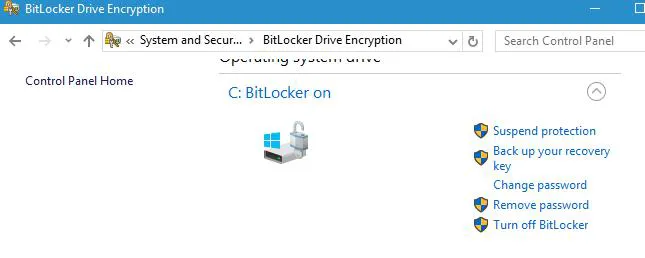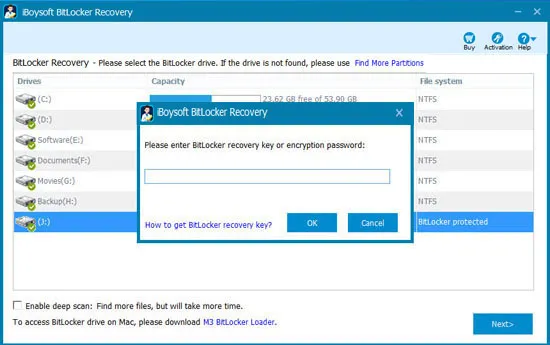What causes BitLocker to ask for a recovery key?
There are several reasons why BitLocker recovery appears and keeps asking for a recovery key on every boot of Windows 10/11:
- Malware attack
- Authentication errors, such as entering incorrect PIN
- Boot/BIOS changes. For example, changes to the master boot record (MBR) on the disk
- Hardware, software, and firmware changes. For example, Windows update causes BitLocker recovery
- Learn more reasons...
As long as there is something that affects the Windows startup routine and causes the hash to be changed and not match what BitLocker expects, Windows 10 boots into the BitLocker recovery screen and asks for the recovery key again and again.
Find the reasons causing BitLocker asking for the recovery key? Share it!
How to stop Windows from asking for a recovery key?
Some users have reported in forum posts that they saw a BitLocker recovery screen asking for a recovery key at startup Windows 10 from Dell, HP, Lenovo, Samsung, ASUS laptops, etc.

After experiencing the computer keeps asking for the recovery key, how to stop it?
Method 1: Suspend BitLocker protection
Entering the recovery key is a quick way to bypass BitLocker recovery screen when the BitLocker recovery key keeps prompting at boot Windows 10/11.
Step 1: Enter the recovery key on the BitLocker recovery screen.
If you log into your computer using a Microsoft account, the encryption starts automatically and the recovery key is backed up to your Microsoft account.
Use another computer or mobile device, go to the site: https://account.microsoft.com/devices/recoverykey, follow the on-screen instructions to log into your Microsoft account and find the recovery key that looks like this:
BitLocker recovery keys
Username you have chosen
Key ID: 5634AB5C
Recovery key: 597795-347886-541236-789456-456789-124567-543216-894567
Step 2: Once Windows OS is started, please go to Start -> Control Panel -> BitLocker Drive Encryption.
Step 3: Click "Suspend protection" option next to the C drive (Or click "Turn off BitLocker" to disable BitLocker drive encryption on C drive).

Step 4: A dialog box window will open asking "Do you want to suspend BitLocker protection?", please press the Yes button to confirm.
Step 5: Wait a few minutes after suspending protection and then click the "Resume protection" option to update BitLocker TPM.
Method 2: Remove the protectors from the boot drive
If you've entered the correct BitLocker recovery key multiple times, and are still unable to continue past the BitLocker recovery screen, follow these steps to break out of the BitLocker recovery screen.
Step 1: On the BitLocker recovery screen, press Esc for more BitLocker recovery options.

Step 2: Select Skip this drive at the right corner.

Step 3: On the next screen, select Troubleshoot.
Step 4: On the Troubleshoot screen, select Advanced options.
Step 5: On the Advanced options screen, select Command prompt.
Step 6: From the WinRE command prompt, manually type the command: manage-bde -unlock C: -rp recoverykey and press Enter.
If manage-bde failed to unlock this BitLocker volume, go to solution 3 and recover data with iBoysoft Data Recovery WinPE edition.
Step 7: Type the command: manage-bde -protectors -disable C: to remove the protectors from the boot drive.
Once the last command is run, you can safely exit the command prompt and continue to boot into your operating system.
Step 8: Restart your computer and enter the recovery key.
Method 3: Enable secure boot
Step 1: On the BitLocker recovery screen, press Esc for more BitLocker recovery options.
Step 2: Select Skip this drive at the right corner.
Step 3: On the next screen, select "Troubleshoot".
Step 4: On the Troubleshoot screen, select "Advanced options".
Step 5: On the Advanced options screen, select "UEFI Firmware Settings", and then select Restart.
Step 6: Your computer will be started to UEFI, select the "Security" section.
Step 7: Click Change Configuration under "Secure Boot".
Step 8: Select "Microsoft Only" and click OK.
Step 9: Select "Exit", and then Restart to reboot the device.
Method 4: Update your BIOS
If you're experiencing a BitLocker password prompt screen problem, the problem might be your BIOS.
To update your BIOS to the latest version, be sure to check your motherboard manual for step-by-step instructions.
Method 5: Disable secure boot
If updating your BIOS has failed to solve the BitLocker password screen problem, we suggest you disable your Secure Boot feature in your BIOS options.
Step 1: On the BitLocker recovery screen, press Esc for more BitLocker recovery options.
Step 2: Select Skip this drive at the right corner.
Step 3: On the next screen, select "Troubleshoot".
Step 4: On the Troubleshoot screen, select "Advanced options".
Step 5: On the Advanced options screen, select "UEFI Firmware Settings", and then select Restart.
Step 6: Your computer will be started to UEFI, find the Secure Boot setting, and set it to Disabled.
Method 6: Use legacy boot
Windows 10 uses a new graphical boot menu, and sometimes the boot menu can cause a BitLocker password prompt screen. So switching back to legacy boot can solve this problem.
Step 1: Type "cmd" in the search bar of the Windows Taskbar.
Step 2: Right-click on cmd.exe and choose "Run as Administrator" to run the command prompt.

Step 3: After seeing the Command Prompt window, type "bcdedit /set {default} bootmenupolicy legacy" and then press Enter.
Method 7: Turn off the auto-unlock option
Generally, when the Auto-unlock option in Windows 10 is enabled, BitLocker keeps asking for a recovery key. So, you can try turning it off to avoid the issue.
Step 1: After Windows OS is started, go to Start -> Control Panel -> BitLocker Drive Encryption.
Step 2: Click the "Turn off auto-unlock" option next to the C drive.
Step 3: After turning off the auto-unlock option, restart your computer. Hopefully, your issue will be resolved after the reboot.
If steps are helpful? Why not share?
Method 8: Update Windows OS
Another common reason why BitLocker keeps asking for recovery key in Windows 10 is that you have an outdated system. Therefore, it is essential to install the latest updates from time to time to avoid this issue.
Step 1: Click Start and then type Update in the search bar.
Step 2: Click on "Check for updates".
Step 3: You will see the available updates, click "Download" or "Download and install" to download and install the updates.
Method 9: Uninstall and reinstall the problematic update
Keeping your system up to date is surely a winning strategy. However some certain updates can cause this problem, and to fix this problem you should uninstall the problematic update and reinstall it.
Step 1: Press the Windows logo key and the I key to open the Settings app.
Step 2: Click Update & Security.
Step 3: Select View your update history.
Step 4: Click Uninstall updates.
Step 5: Locate the problematic update and double-click it to uninstall it.
Step 6: Restart your computer.
Step 7: After removing the update you need to temporarily suspend BitLocker in Control Panel.
Step 8: Reinstall the update. Simply go to the Windows Update section in the Settings app and check for updates to automatically download the missing update.
Step 9: Resume BitLocker protection in the Control Panel.
Method 10: Uninstall the newly installed hardware
If you have installed new hardware, it may create issues with the BitLocker. What you need to do is make sure no unnecessary external devices are connected to your computer when booting.
Method 11: Recover data from BitLocker encrypted OS drive
If you are unable to pass the BitLocker recovery prompt screen with the above solutions, try to recover data from the corrupted BitLocker encrypted OS drive with professional data recovery software.
iBoysoft Data Recovery is a professional data recovery software that can recover deleted files, recover lost data from formatted drives, recover data from RAW, inaccessible, corrupted drives, recover lost data from deleted/lost partitions, recover lost data from BitLocker encrypted drives on Windows 11/10/8/7/XP and Windows Server 2016/2012/2008/2003.
iBoysoft Data Recovery also provides a WinPE boot disk which can recover data from BitLocker encrypted drive after the computer crashes or fails.
Step 1: Download iBoysoft Data Recovery WinPE edition: iboysoftdatarecovery.iso.
Step 2: Burn the iBoysoft Data Recovery WinPE edition: iboysoftdatarecovery.iso file to a USB drive with the burning tool.
Step 3: Set the computer to be booted from the iBoysoft Data Recovery WinPE boot disk.
Step 4: Boot your computer from iBoysoft Data Recovery WinPE boot disk.
Step 5: Once iBoysoft Data Recovery is loaded, choose the BitLocker Recovery module.

Step 6: Select BitLocker encrypted OS drive.
Step 7: Enter the 48-digit BitLocker recovery key and then click OK to decrypt data from the BitLocker encrypted OS drive.

The 48-digit recovery key is the only way to decrypt data from BitLocker encrypted OS drive due to TPM. If you don't have it, there is no way to recover lost data with iBoysoft Data Recovery.
Step 8: iBoysoft Data Recovery is scanning the data from BitLocker encrypted OS drive.

Step 9: After the scan completes, select the files and click Recover to start the data recovery process.

Method 12: Format the C: drive and reinstall Windows OS
If you don't care about the data stored on the C drive, formatting the C: drive and reinstalling Windows OS is the best choice to solve Windows asking for a recovery key problem.
Problem solved? Let's share the happiness with other people!
